Tackling Age of Information in Access Policies for Sensing Ecosystems †
Abstract
1. Introduction
2. Scenario and Methodology
3. Multiple Access
3.1. Concurrent Multiple Access
3.2. Time-Division Multiple Access
4. ML-Based Sensor Transmission Optimization Using AoI
Results
5. Conclusions and Future Work
Author Contributions
Funding
Conflicts of Interest
References
- Kor, A.L.; Yanovsky, M.; Pattinson, C.; Kharchenko, V. SMART-ITEM: IoT-enabled smart living. In Proceedings of the 2016 Future Technologies Conference (FTC), San Francisco, CA, USA, 6–7 December 2016; pp. 739–749. [Google Scholar] [CrossRef]
- Cisotto, G.; Pupolin, S. Evolution of ICT for the improvement of quality of life. IEEE Aerosp. Electron. Syst. Mag. 2018, 33, 6–12. [Google Scholar] [CrossRef]
- Ali, S.; Kim, D.H. Simulation and energy management in smart environment using ensemble of GA and PSO. Wirel. Pers. Commun. 2020, 114, 49–67. [Google Scholar] [CrossRef]
- Ullo, S.L.; Sinha, G.R. Advances in Smart Environment Monitoring Systems Using IoT and Sensors. Sensors 2020, 20, 3113. [Google Scholar] [CrossRef] [PubMed]
- Ma, M.; Wang, P.; Chu, C.H. Data management for Internet of things: Challenges, approaches and opportunities. In Proceedings of the 2013 IEEE International Conference on Green Computing and Communications and IEEE Internet of Things and IEEE Cyber, Physical and Social Computing, Washington, DC, USA, 20–23 August 2013; pp. 1144–1151. [Google Scholar] [CrossRef]
- Yates, R.D.; Kaul, S.K. Status updates over unreliable multiaccess channels. In Proceedings of the 2017 IEEE International Symposium on Information Theory (ISIT), Aachen, Germany, 25–30 June 2017; pp. 331–335. [Google Scholar] [CrossRef]
- Kadota, I.; Uysal-Biyikoglu, E.; Singh, R.; Modiano, E. Minimizing the age of information in broadcast wireless networks. In Proceedings of the 2016 54th Annual Allerton Conference on Communication, Control, and Computing (Allerton), Monticello, IL, USA, 27–30 September 2016; pp. 844–851. [Google Scholar] [CrossRef]
- Fountoulakis, E.; Pappas, N.; Codreanu, M.; Ephremides, A. Optimal sampling cost in wireless networks with age of information constraints. In Proceedings of the IEEE INFOCOM 2020-IEEE Conference on Computer Communications Workshops (INFOCOM WKSHPS), Toronto, ON, Canada, 6–9 July 2020; pp. 918–923. [Google Scholar]
- Badia, L. Age of information from two strategic sources analyzed via game theory. In Proceedings of the 2021 IEEE 26th International Workshop on Computer Aided Modeling and Design of Communication Links and Networks (CAMAD), Porto, Portugal, 25–27 October 2021; pp. 1–6. [Google Scholar] [CrossRef]
- Bacinoglu, B.T.; Ceran, E.T.; Uysal-Biyikoglu, E. Age of information under energy replenishment constraints. In Proceedings of the 2015 Information Theory and Applications Workshop (ITA), San Diego, CA, USA, 1–6 February 2015; pp. 25–31. [Google Scholar] [CrossRef]
- Crosara, L.; Badia, L. A Stochastic Model for Age-of-Information Efficiency in ARQ Systems with Energy Harvesting. In Proceedings of the European Wireless 2021, 26th European Wireless Conference, Verona, Italy, 10–12 November 2021; pp. 1–6. [Google Scholar]
- Wu, X.; Yang, J.; Wu, J. Optimal status update for age of information minimization with an energy harvesting source. IEEE Trans. Green Commun. Netw. 2017, 2, 193–204. [Google Scholar] [CrossRef]
- Badia, L. On the impact of correlated arrivals and errors on ARQ delay terms. IEEE Trans. Commun. 2009, 57, 334–338. [Google Scholar] [CrossRef]
- Zhou, B.; Saad, W. On the age of information in Internet of Things systems with correlated devices. In Proceedings of the Globecom 2020–2020 IEEE Global Communications Conference, Taipei, Taiwan, 7–11 December 2020; pp. 1–6. [Google Scholar] [CrossRef]
- Kalør, A.E.; Popovski, P. Minimizing the age of information from sensors with common observations. IEEE Wirel. Commun. Lett. 2019, 8, 1390–1393. [Google Scholar] [CrossRef]
- Zancanaro, A.; Cisotto, G.; Badia, L. Modeling Value of Information in Remote Sensing from Correlated Sources. Comput. Commun. 2023, 203, 289–297. [Google Scholar] [CrossRef]
- Berardo, A.; Fattoruso, V.; Mazzoni, V.; Pugno, N.M. Coupling computational vibrational models and experimental biotremology to develop a green pest control strategy against the greenhouse whitefly Trialeurodes vaporariorum. J. R. Soc. Interface 2022, 19, 20220311. [Google Scholar] [CrossRef] [PubMed]
- Cisotto, G.; Guglielmi, A.V.; Badia, L.; Zanella, A. Joint compression of EEG and EMG signals for wireless biometrics. In Proceedings of the 2018 IEEE Global Communications Conference (Globecom), Abu Dhabi, United Arab Emirates, 9–13 December 2018; pp. 1–6. [Google Scholar] [CrossRef]
- Shiraishi, J.; Chiariotti, F.; Leyva-Mayorga, I.; Popovski, P.; Yomo, H. Query Timing Analysis for Content-based Wake-up Realizing Informative IoT Data Collection. IEEE Wirel. Commun. Lett. 2023, 12, 327–331. [Google Scholar] [CrossRef]
- Munari, A. On the Value of Retransmissions for Age of Information in Random Access Networks without Feedback. In Proceedings of the Globecom 2022–2022 IEEE Global Communications Conference, Rio de Janeiro, Brazil, 4–8 December 2022; pp. 4964–4970. [Google Scholar]
- Elgabli, A.; Khan, H.; Krouka, M.; Bennis, M. Reinforcement learning based scheduling algorithm for optimizing age of information in ultra reliable low latency networks. In Proceedings of the 2019 IEEE Symposium on Computers and Communications (ISCC), Barcelona, Spain, 29 June–3 July 2019; pp. 1–6. [Google Scholar] [CrossRef]
- Samir, M.; Assi, C.; Sharafeddine, S.; Ebrahimi, D.; Ghrayeb, A. Age of information aware trajectory planning of UAVs in intelligent transportation systems: A deep learning approach. IEEE Trans. Veh. Technol. 2020, 69, 12382–12395. [Google Scholar] [CrossRef]
- Uysal, E.; Kaya, O.; Baghaee, S.; Beytur, H.B. Age of Information in Practice; Age of Information; Cambridge University Press: Cambridge, UK, 2022. [Google Scholar] [CrossRef]
- Braei, M.; Wagner, S. Anomaly Detection in Univariate Time-series: A Survey on the State-of-the-Art. arXiv 2020, arXiv:2004.00433. [Google Scholar] [CrossRef]
- Badia, L. On the Effect of Feedback Errors in Markov Models for SR ARQ Packet Delays. In Proceedings of the Globecom 2009–2009 IEEE Global Telecommunications Conference, Honolulu, HI, USA, 30 November–4 December 2009; pp. 1–6. [Google Scholar] [CrossRef]
- Jin, W.; Sun, J.; Chi, K.; Zhang, S. Deep reinforcement learning based scheduling for minimizing age of information in wireless powered sensor networks. Comput. Commun. 2022, 191, 1–10. [Google Scholar] [CrossRef]
- Crosara, L.; Zancanaro, A.; Cisotto, G.; Laurenti, N.; Badia, L. Analytical Evaluation of Age of Information in Networks of Correlated Sources. In Proceedings of the 2022 IEEE Workshop on Metrology for Agriculture and Forestry (MetroAgriFor), Perugia, Italy, 3–5 November 2022; pp. 323–328. [Google Scholar] [CrossRef]
- Bellavista, P.; Foschini, L.; Mora, A. Decentralised Learning in Federated Deployment Environments: A System-Level Survey. ACM Comput. Surv. 2021, 54, 1–38. [Google Scholar] [CrossRef]
- Ceran, E.T.; Gündüz, D.; György, A. Reinforcement learning to minimize age of information with an energy harvesting sensor with HARQ and sensing cost. In Proceedings of the IEEE Infocom 2019-IEEE Conference on Computer Communications Workshops (INFOCOM WKSHPS), Paris, France, 29 April–2 May 2019; pp. 656–661. [Google Scholar]
- Wang, S.; Chen, M.; Yang, Z.; Yin, C.; Saad, W.; Cui, S.; Poor, H.V. Distributed Reinforcement Learning for Age of Information Minimization in Real-Time IoT Systems. IEEE J. Sel. Top. Signal Process. 2022, 16, 501–515. [Google Scholar] [CrossRef]
- Fang, Z.; Wang, J.; Ren, Y.; Han, Z.; Poor, H.V.; Hanzo, L. Age of Information in Energy Harvesting Aided Massive Multiple Access Networks. IEEE J. Sel. Areas Commun. 2022, 40, 1441–1456. [Google Scholar] [CrossRef]
- Tong, J.; Fu, L.; Han, Z. Age-of-Information Oriented Scheduling for Multichannel IoT Systems with Correlated Sources. IEEE Trans. Wirel. Commun. 2022, 21, 9775–9790. [Google Scholar] [CrossRef]
- Zancanaro, A.; Cisotto, G.; Badia, L. Challenges of the Age of Information Paradigm for Metrology in Cyberphysical Ecosystems. In Proceedings of the 2022 IEEE International Workshop on Metrology for Living Environment (MetroLivEn), Cosenza, Italy, 25–27 May 2022; pp. 127–131. [Google Scholar] [CrossRef]
- Jung, P. Time Division Multiple Access (TDMA). In Wiley Encyclopedia of Telecommunications; John Wiley & Sons, Inc.: Hoboken, NJ, USA, 2003. [Google Scholar] [CrossRef]
- Munari, A. Modern random access: An age of information perspective on irregular repetition slotted ALOHA. IEEE Trans. Commun. 2021, 69, 3572–3585. [Google Scholar] [CrossRef]
- Badia, L.; Zanella, A.; Zorzi, M. Game Theoretic Analysis of Age of Information for Slotted ALOHA Access with Capture. In Proceedings of the IEEE INFOCOM 2022-IEEE Conference on Computer Communications Workshops (INFOCOM WKSHPS), Virtual, 2–5 May 2022; pp. 1–6. [Google Scholar]
- Rajasegarar, S.; Leckie, C.; Palaniswami, M. Anomaly detection in wireless sensor networks. IEEE Wirel. Commun. 2008, 15, 34–40. [Google Scholar] [CrossRef]
- Abkenar, F.S.; Badia, L.; Levorato, M. Selective Data Offloading in Edge Computing for Two-Tier Classification with Local Domain Partitions. In Proceedings of the IEEE PerCom Workshops, Atlanta, GA, USA, 13–17 March 2023. [Google Scholar]
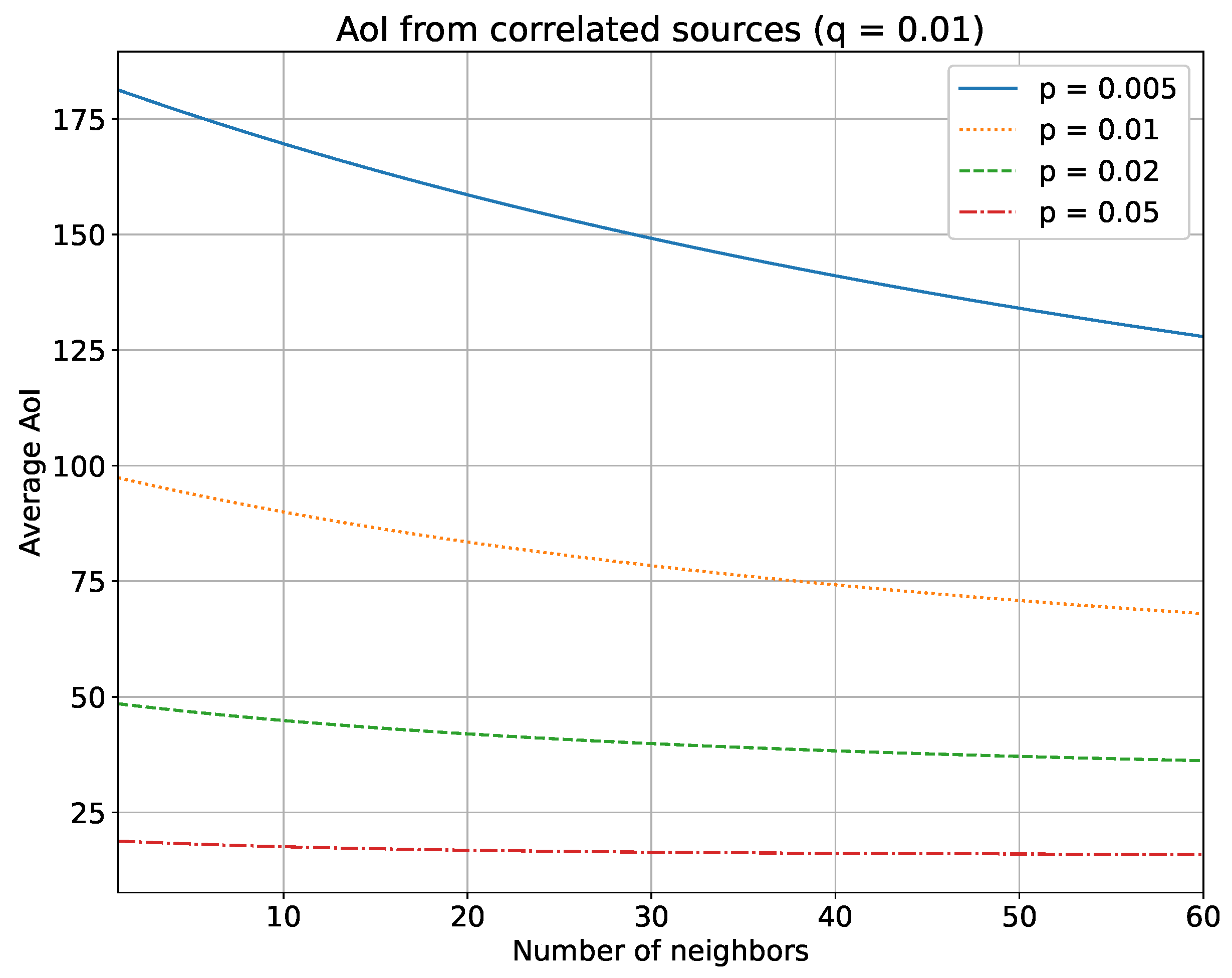
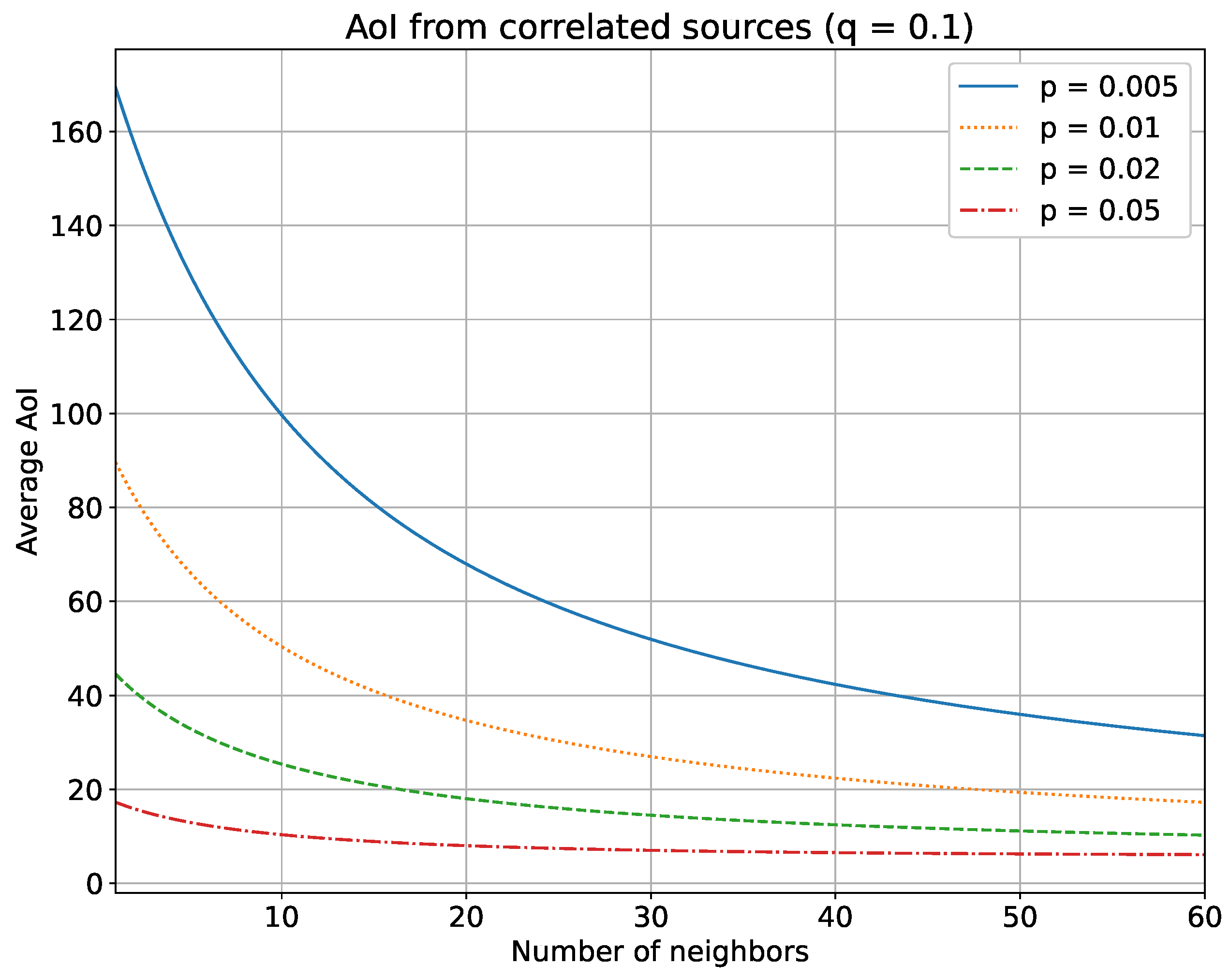

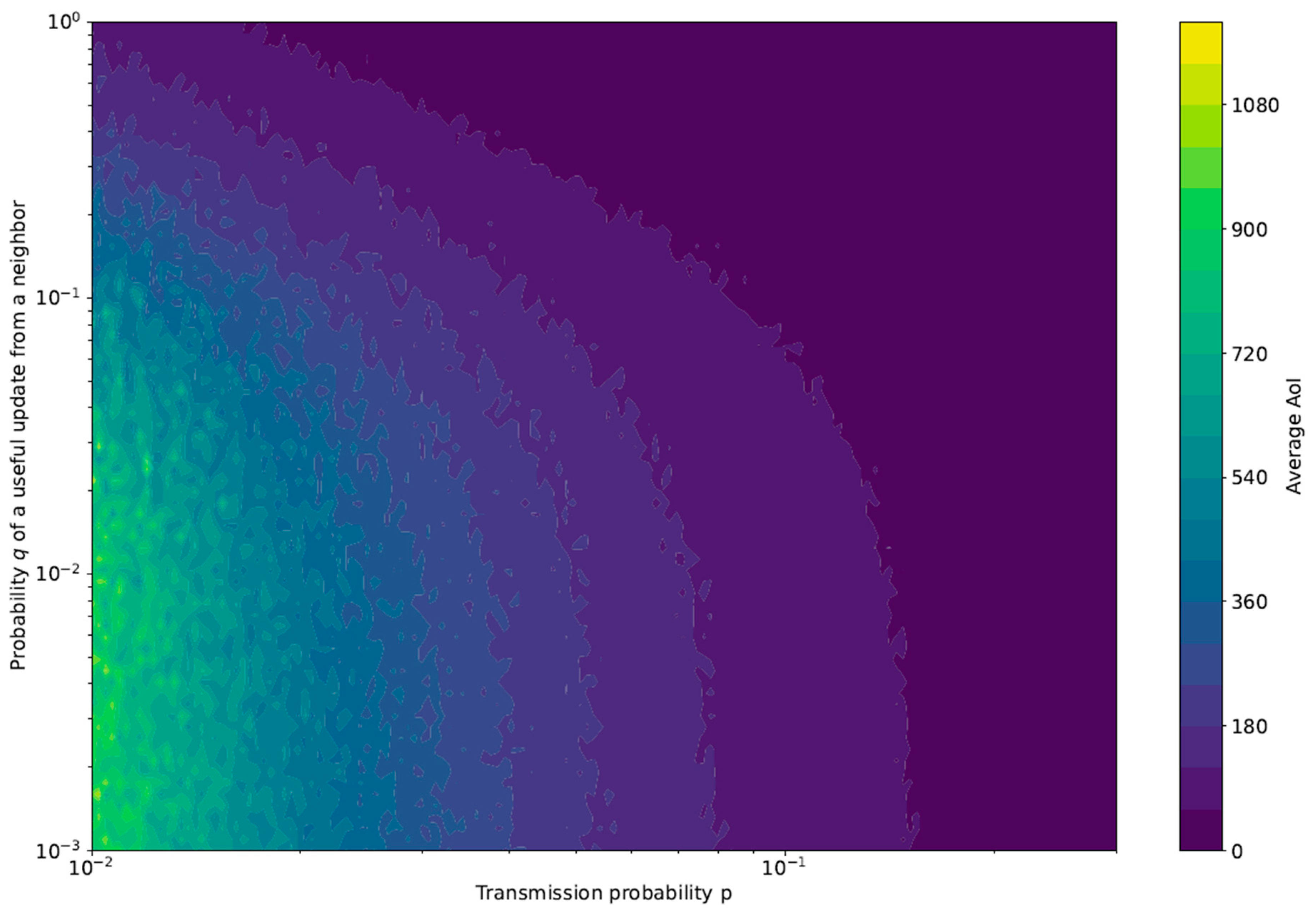
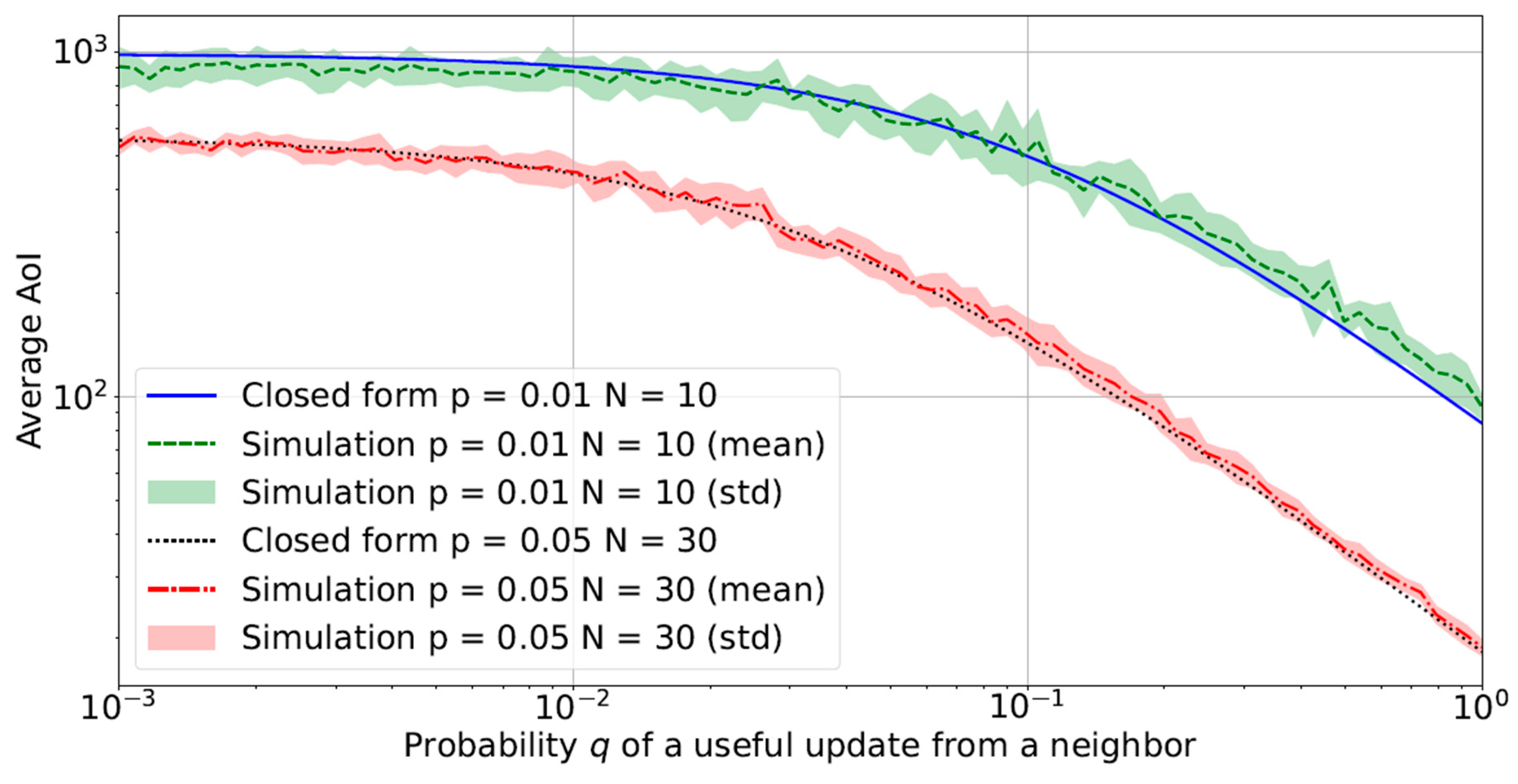

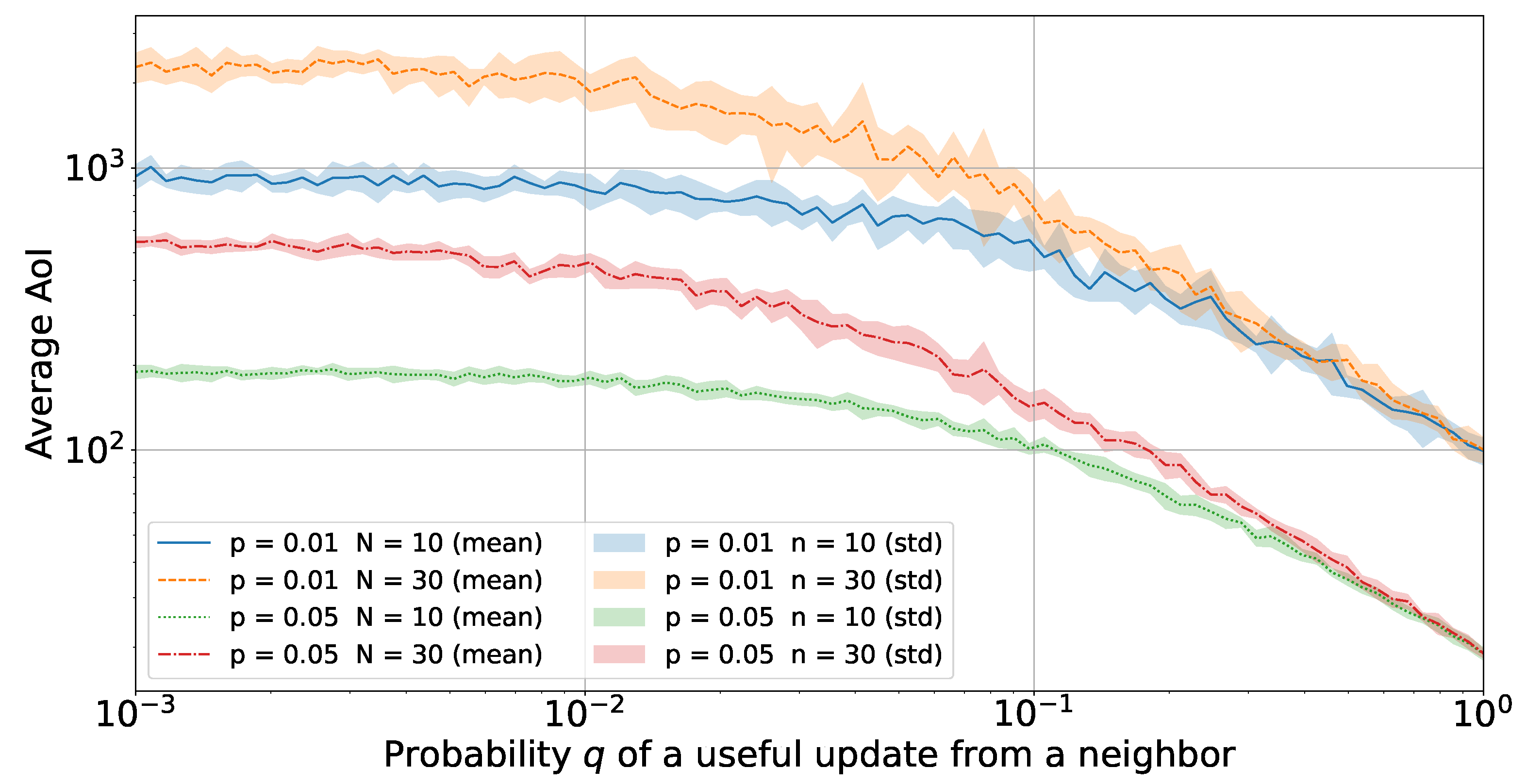

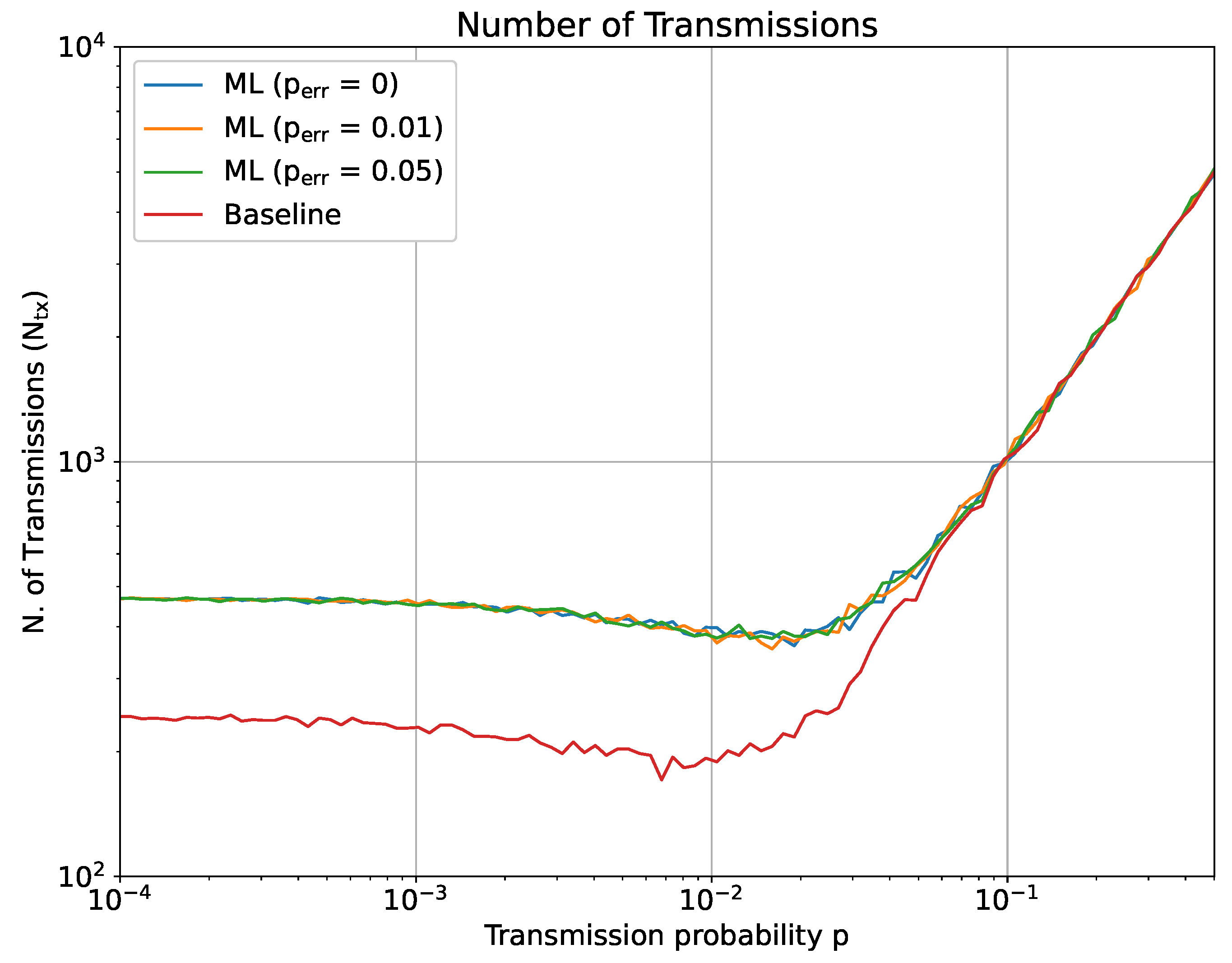
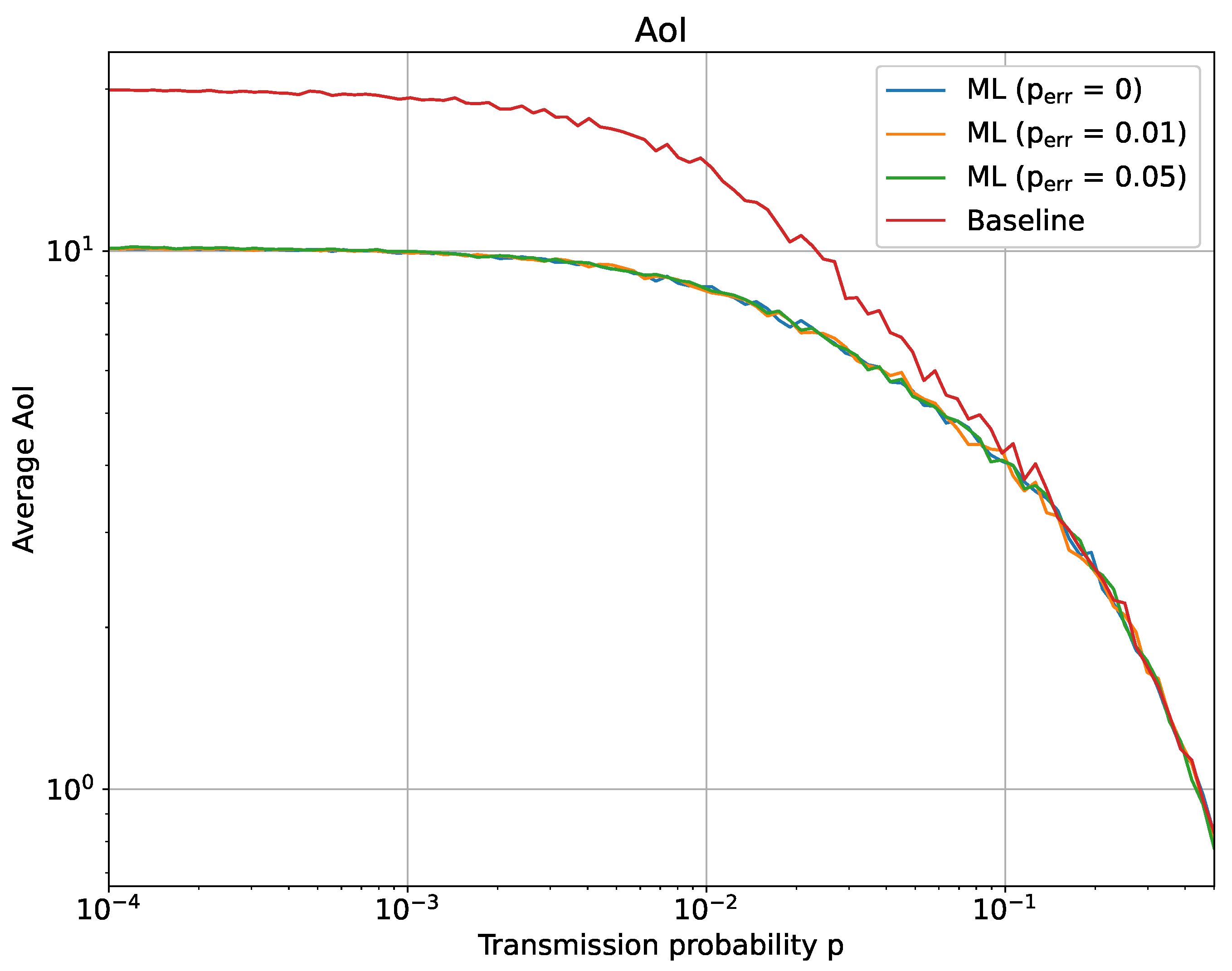
| AoI | Energy | Correlation | Machine Learning | Transmission Policies | |
|---|---|---|---|---|---|
| Bacinoglu et al. [10] | X | X | X | ||
| Wu et al. [12] | X | X | X | X | |
| Kalor and Popovski [15] | X | X | X | ||
| Safdar and Do-Hyun. [3] | X | X | |||
| Zhou and Saad [14] | X | X | X | ||
| Samir et al. [22] | X | X | X | ||
| Jin et al. [26] | X | X | X | ||
| Fountoulaki et al. [8] | X | X | |||
| Badia [9] | X | X | X | ||
| Crosara and Badia [11] | X | X | X | ||
| Zancanaro et al. [16] | X | X | |||
| Elgabli et al. [21] | X | X | |||
| Crosara et al. [27] | X | X | |||
| Bellavista et al. [28] | X | X | |||
| Ceran et al. [29] | X | X | X | ||
| Wang et al. [30] | X | X | X | ||
| Fang et al [31] | X | X | X | ||
| Tong et al. [32] | X | X | |||
| Shiraishi et al. [19] | X | X | X | X | |
| Zancanaro et al. [33] | X | X | X | X | |
| Our work | X | X | X | X | X |
| Notation | Definition |
|---|---|
| Multiple Access (Section 3) | |
| t | time slot index |
| N | no. sensor nodes |
| p | transmission probability of every sensor |
| q | probability of useful transmission from a neighbor node |
| duration of a time slot | |
| probability that the AoI has value i | |
| ML-based AoI optimization (Section 4) | |
| no. transmissions | |
| initial AoI threshold for the ML simulation | |
| T | AoI threshold during the ML simulation |
| probability of mis-classification for the ML algorithm | |
Disclaimer/Publisher’s Note: The statements, opinions and data contained in all publications are solely those of the individual author(s) and contributor(s) and not of MDPI and/or the editor(s). MDPI and/or the editor(s) disclaim responsibility for any injury to people or property resulting from any ideas, methods, instructions or products referred to in the content. |
© 2023 by the authors. Licensee MDPI, Basel, Switzerland. This article is an open access article distributed under the terms and conditions of the Creative Commons Attribution (CC BY) license (https://creativecommons.org/licenses/by/4.0/).
Share and Cite
Zancanaro, A.; Cisotto, G.; Badia, L. Tackling Age of Information in Access Policies for Sensing Ecosystems. Sensors 2023, 23, 3456. https://doi.org/10.3390/s23073456
Zancanaro A, Cisotto G, Badia L. Tackling Age of Information in Access Policies for Sensing Ecosystems. Sensors. 2023; 23(7):3456. https://doi.org/10.3390/s23073456
Chicago/Turabian StyleZancanaro, Alberto, Giulia Cisotto, and Leonardo Badia. 2023. "Tackling Age of Information in Access Policies for Sensing Ecosystems" Sensors 23, no. 7: 3456. https://doi.org/10.3390/s23073456
APA StyleZancanaro, A., Cisotto, G., & Badia, L. (2023). Tackling Age of Information in Access Policies for Sensing Ecosystems. Sensors, 23(7), 3456. https://doi.org/10.3390/s23073456








